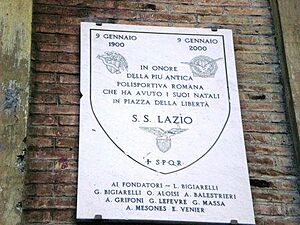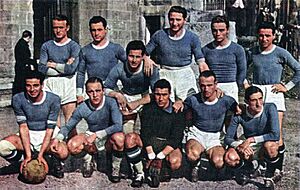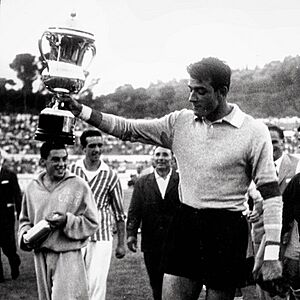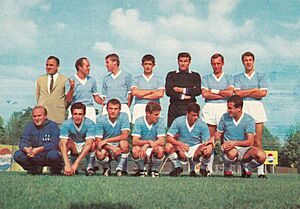History of SS Lazio facts for kids
S.S. Lazio is a famous football club from Rome, Italy. It was started in 1900, and its history goes back over 110 years!
Contents
- How Lazio Started and Its First Years
- The 1930s: A New National League
- The 1940s: World War II and Tough Times
- The 1950s: Lazio's First Big Win
- The 1960s: First Time in Serie B
- The 1970s: Lazio's First League Title!
- The 1980s: Difficult Times
- The 1990s: The Cragnotti Years
- The 2000s: The Lotito Years
- Images for kids
- See also
How Lazio Started and Its First Years
The club, first called Società Podistica Lazio, began on January 9, 1900. It was founded in a part of Rome called Prati. This makes Lazio the oldest football team still playing in Rome! The nine people who started the club wanted it to represent more than just the city. So, they named it Lazio, which is the region where Rome is located. They chose sky blue as the main color to honor ancient Greece and the start of the modern Olympic Games.
Lazio played its very first match in 1902 against a team called Virtus. Many people see this as the first "Rome Derby," even if it wasn't official. Lazio won that game 3-0, with Sante Ancherani scoring all three goals!
In 1907, the Italian Football Federation (FIGC) held a championship just for Roman teams. Lazio won it, beating their early rivals Virtus in the final. But even with this win, they weren't invited to play in any national championships yet.
Lazio officially started its football section in 1910. They joined the official league in 1912 when the FIGC began organizing championships in central and southern Italy. Lazio reached the national final three times but never won. They lost in 1913, 1914, and 1923.
When the FIGC started its first full national championship in 1926, Lazio played in the Prima Divisione, which was like today's Serie B. In 1927, the government tried to combine all of Rome's football teams into one, which became A.S. Roma. Lazio was the only big Roman club that managed to stay independent. This was thanks to Giorgio Vaccaro, a general and a big Lazio fan, who helped the club keep its own identity.
The 1930s: A New National League
Lazio played in the first organized Serie A season in 1929. Their first game was on October 6, 1929, where they beat Bologna 3-0. However, their first season wasn't great, and they finished in 15th place.
In these early Serie A years, Lazio had many players from Brazil, earning them the nickname "Brasilazio." Their coach, Amílcar Barbuy, was the first Brazilian to work in Italian football. But this didn't bring them much success, as they finished 8th and 13th in the next two seasons.
In 1932, an Austrian coach named Karl Stürmer took over. He led Lazio to their first win in a Derby della Capitale (the big match against Roma), beating them 2-1 at home. After two more seasons, another Austrian coach, Walter Alt, arrived in 1934. This was also when two star players joined: Silvio Piola and Attilio Ferraris. Ferraris came from Roma, and Piola became a Lazio legend. He is still one of the highest goalscorers in Serie A history and won the FIFA World Cup with Italy in 1938.
With the amazing striker Piola, Lazio finished second in 1937, which was their best result before World War II. They also played in a European competition for the first time, reaching the final of the Central European Cup. Lazio ended the decade with a 2-0 win against Roma in 1939 and a strong 4th-place finish in 1940.
The 1940s: World War II and Tough Times
The 1940s were tough for Lazio. Another team, Torino, was dominating Italian football. Lazio usually finished in the middle of the league table. The championship was stopped in 1943 because of World War II. Lazio, now without their hero Piola, played in a local Roman championship until 1945–46. The national championship returned the next year, and Lazio finished 10th, ahead of Roma, who barely avoided being sent down to a lower league.
The 1948–49 season was very hard for Lazio. Players were paid very little, and some even went on strike. They finished 13th. However, they bounced back the next season with an impressive 4th-place finish. This was even sweeter because of the difficulties they faced and because Roma again barely avoided relegation.
The 1950s: Lazio's First Big Win
Lazio returned to European competitions in 1950, playing in the Latin Cup, which was a very important tournament then. The next year, they played in the Mitropa Cup, finishing 4th. These European games came alongside good results in Italy, with two more 4th-place finishes.
From 1952 to 1955, the club had three average seasons, finishing in the middle of the table. But then they had two great seasons, finishing 3rd both times. Two important players joined during this time: Swedish forward Arne Selmosson and Ermes Muccinelli from Juventus.
In 1958, Lazio won its first major trophy: the Coppa Italia. They won their group, then beat other teams to reach the final against Fiorentina. Led by coach Fulvio Bernardini, Lazio won 1-0 with a goal from Maurilio Prini, who used to play for Fiorentina!
The 1960s: First Time in Serie B
The 1960s started poorly for Lazio. In the 1960–61 season, they finished last and were sent down to Serie B for the first time.
Their first season in Serie B (1961–62) was disappointing. They missed out on getting promoted back to Serie A by just one point. However, the next season, they did get promoted, finishing 3rd. Their coach was an Argentine, Juan Carlos Lorenzo. Lazio's strong defense helped them finish 8th in 1964, letting in very few goals. A 3-0 away win against Juventus was a highlight!
Soon, the club faced money problems. Umberto Lenzini became the new president and made a big difference. Lazio was soon relegated back to Serie B. Even though they were expected to get promoted quickly, they only finished 11th. Juan Carlos Lorenzo returned as coach, and with some new players, he led Lazio to win Serie B in 1969. A key player during these years was midfielder Nello Governato.
The 1970s: Lazio's First League Title!
The 1970s began like the 1960s, with Lazio being relegated after the 1970–71 season. But getting promoted the next year started Lazio's first truly successful time. In the 1972–73 season, they had a strong team with captain Giuseppe Wilson, midfielders Luciano Re Cecconi and Mario Frustalupi, and forwards Renzo Garlaschelli and Giorgio Chinaglia. Their coach was Tommaso Maestrelli.
With Chinaglia scoring goals and the defense playing tough, Lazio became a surprise contender for the Scudetto (the league title) in 1972–73. They just missed out on the last day of the season. But this was just a warm-up! In the 1973–74 season, Lazio won their first league title, leading the whole season!
Sadly, they couldn't build on this success. They finished 4th the next year, then struggled to avoid relegation in 1975–76. The tragic deaths of Luciano Re Cecconi and their winning coach Tommaso Maestrelli, plus Chinaglia leaving in 1976, were big blows. However, Bruno Giordano became a star during this time, finishing as Serie A's top scorer in 1979, when Lazio finished 8th.
The 1980s: Difficult Times
In 1980, Lazio was forced down to Serie B because of a scandal involving illegal bets on their own matches. They stayed in Italy's second division for three seasons. This was a very dark time in Lazio's history. They returned to Serie A in 1983 and managed to avoid relegation on the very last day of the next season. The 1984–85 season was very tough, as they finished last with only 15 points.
In 1986, Lazio was hit with a nine-point penalty because of another betting scandal involving a player. This was a huge penalty back when a win only gave two points. An amazing fight against relegation followed in Serie B. The club, led by coach Eugenio Fascetti, only avoided being sent down to Serie C after winning special play-off games. This moment became a turning point for the club. Lazio returned to Serie A in 1988. Under the careful financial management of Gianmarco Calleri, the club became a stable team in the top league.
The 1990s: The Cragnotti Years
When Sergio Cragnotti arrived in 1992, he changed the club's history forever. He was ready to invest a lot of money in new players to make Lazio a top team in Serie A. Cragnotti often broke transfer records to sign major stars. He bought Juan Sebastián Verón for £18 million, Christian Vieri for £19 million, and even broke the world transfer record (for a few weeks) to sign Hernán Crespo for £35 million!
Lazio had great results in the 1990s:
- 1993: 5th place
- 1994: 4th place
- 1995: 2nd place
- 1996: 3rd place
- 1997: 4th place
In 1999, they lost the championship by just one point on the last day. But with players like Siniša Mihajlović, Alessandro Nesta, and Pavel Nedvěd, Lazio finally won its second scudetto in 2000! They also won the Coppa Italia that year, achieving a "double" (winning both the league and cup). Their manager was Sven-Göran Eriksson.
Besides the 2000 Coppa Italia, Lazio also won it in 1998. Lazio won the very last UEFA Cup Winners' Cup in 1999. They also reached the UEFA Cup final in 1998 but lost 0-3 to Internazionale. Lazio won the Supercoppa Italiana twice and beat 1999 Champions League winners Manchester United in 1999 to win the UEFA Super Cup. In 2000, Lazio became the first Italian football club to be listed on the Italian stock market.
The 2000s: The Lotito Years
Lazio started the 2000s well, winning the Supercoppa Italiana and finishing 3rd in the league. But when manager Sven-Göran Eriksson left, the club started to decline. With money running out, or being spent on players who didn't perform well, Lazio missed out on qualifying for the UEFA Champions League in 2001–02, finishing 6th.
A financial problem involving Cragnotti and his company forced him to leave the club in 2002. Lazio was then managed by financial caretakers and banks until 2004. This meant the club had to sell its star players, including their captain and club "symbol," Alessandro Nesta. Lazio was later sold to a businessman named Claudio Lotito, who is still the main owner today.
That summer, 36-year-old former Lazio star Paolo Di Canio agreed to join the club he supported as a child, even taking a 75% pay cut. In the 2005–06 season, Lazio let go of many older players to reduce their salaries. Under coach Delio Rossi, the club played much better than expected. They combined remaining experienced players like Angelo Peruzzi with new, motivated players who had lower salary demands. This plan worked, and the club qualified for the 2006–07 UEFA Cup.
On July 14, it was announced that Lazio would be sent down to Serie B with a seven-point penalty because of their involvement in the Calciopoli scandal. However, the club appealed, and on July 25, Lazio's penalty was reduced to an 11-point deduction for the next Serie A season (later reduced to three points). They also lost their qualification for the 2006–07 UEFA Cup. Despite the points deduction, Lazio finished 3rd in the 2006–07 Serie A season! They almost broke the club record for consecutive wins, getting eight in a row (the 2000 title-winning team had nine).
In the 2007–08 and 2008–09 seasons, Lazio finished 12th and 10th. They won the 2008–09 Coppa Italia on May 13, 2009. Lazio started their 2009–10 season by playing against Internazionale in Beijing for the 2009 Supercoppa Italiana. They won the match 2-1 with goals from Matuzalém and Tommaso Rocchi.
Lazio won the 2012–13 Coppa Italia 1-0 against their rivals Roma, with the only goal scored by Senad Lulić. Lazio also won the 2018–19 Coppa Italia 2-0 against Atalanta, which was their seventh Coppa Italia title overall.
Images for kids
See also
- List of S.S. Lazio seasons







